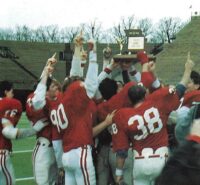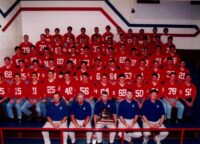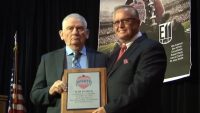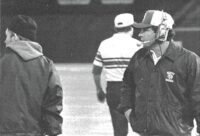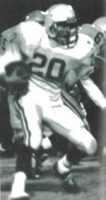Inductees
1983-1996 Era Seneca High School Football
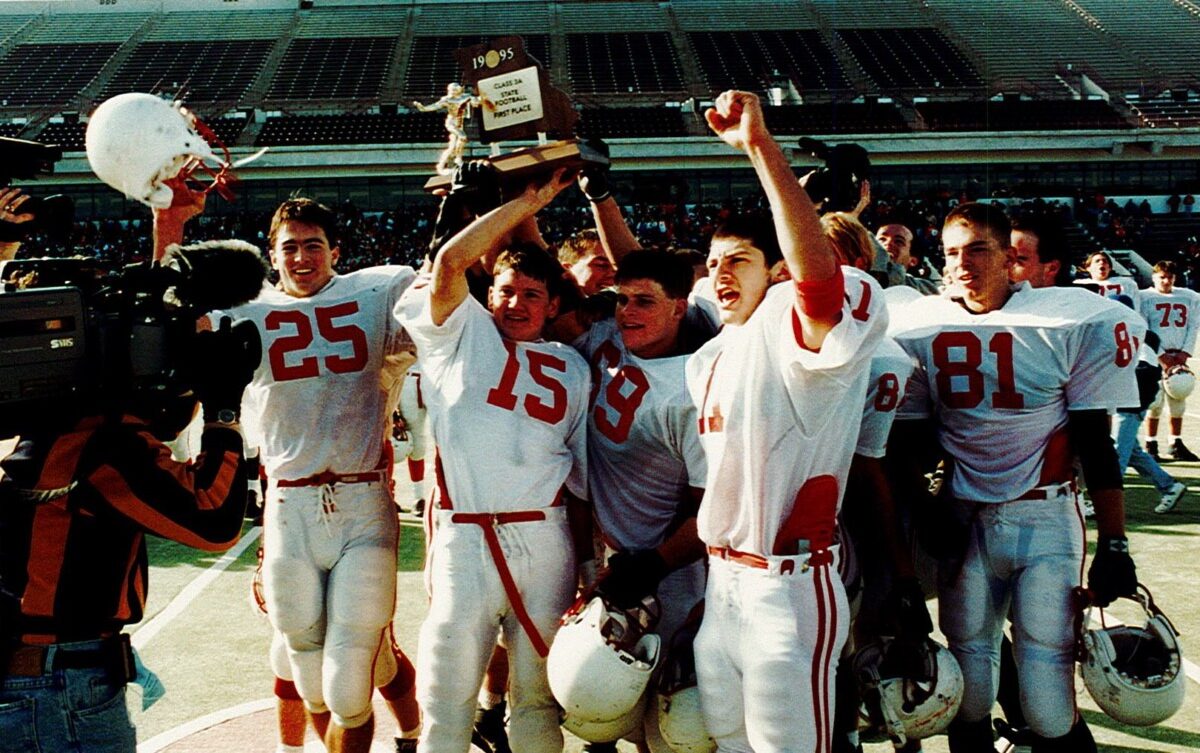
In the trophy case, the state football championship trophies don’t sit alone. Not far from those commemorating the 1987 and 1995 seasons, you’ll find the showpieces proudly reminding all of many autumns gone by.
From there, walk out the back door of the cafeteria and there it is, the quaint football stadium, where the bleachers all but hug the sidelines. Or, as one former player put it, “The fans could spit on us if they wanted to.”
Welcome to Seneca High School Football, home of the knock-you-down and pick-you-back-up Indians, whose tradition fueled one of the most dominate runs in state history.
That’s why the Missouri Sports Hall of Fame proudly inducted the 1983-1996 Era of Seneca High School Football with the Class of 2022. Coached by Tom Hodge (MSHOF 2016), the Indians compiled a 137-31 record and reached the playoffs 11 times.
They won it all in 1987 and 1995 and finished as state runners-up in 1983 and 1986. Seneca reached the state semifinals in 1991 and 1994, and the Indians were quarterfinalists in 1989, 1993 and 1996. Additionally, they won district titles in 1985 and 1990.
This for a program whose roots date to the end of World War II, with several teams of the 1960s and 1970s inspiring what was to come.
“Those coaches and players created a culture that became tradition, pride and class and fueled this successful run,” said Hodge, who played on the 10-0 1964 team and was a scout for the 1968 and 1975 state runner-up teams. “That’s the great thing about this place. Our tradition goes back to the ‘40s just consistently putting out a bunch of good kids.”
Seneca won with farm boys in a community that didn’t typically benefit from a large industry attracting families (and talent) to the town of 2,300.
Overall, they won with a ground attack out of a double tight end set most years and changed up defenses based on talent on hand.
Said 1988 graduate Shannon Crouch (MSHOF Elite 11, 2017), whose 7,476 all-purpose yards rank fifth in the state, “The thing Seneca would always do to you is punch you in the mouth.”
True, but Hodge also demanded they help opposing players off the ground. As he put it, the motto was, “Tradition, Pride and Class.”
Certainly, Seneca was on a mission after the 1982 season. That year, the Indians finished 8-2 and, with MSHSAA’s postseason based on a points system, missed the playoffs by one-tenth of a point.
“(In 1983), we were in every dadgum game,” lineman Kevin Durbin said.
The 1983 team (8-2) reached the state championship game by beating Lexington 17-15 thanks to Randy Keener’s field goal, Seneca’s only field goal that season. A packed home stadium fueled the fire.
“(Winning) was because of the fans,” Durbin said. “That place was rocking.”
The 1986 team (13-1) surged after 8-7, 14-12 and 14-6 mid-season wins and tore through the playoffs, falling only to Louisiana in the finals.
The 1987 (14-0) won it all by beating Brentwood 20-13 at Faurot Field in Columbia.
“Our success should be credited to our work team,” Crouch said. “Those guys prepared us for Friday nights.”
The 1989 and 1990 teams were stopped by Warsaw, which won the 1990 state title.
The 1991 team (11-1) reached the semifinals before falling 12-8 to eventual state champion John Burroughs.
The 1992 (7-3) and 1993 (11-1) teams were eliminated by Bolivar, which finished as the state runner-up in 1992 and brought a lot of talent back for 1993.
That was the era that saw Mac Whitehead (MSHOF Elite 11, 2021) rush for a career 4,947 yards.
The 1994 team (11-2) was eliminated by eventual state champion Odessa. However, a playoff victory against No. 1-ranked Branson planted a seed in players’ minds that Seneca had far more in the tank.
Sure enough, the 1995 team (14-0) showed it, beating Herculaneum 35-14 by running an inverted wishbone. In the playoffs that year, Seneca’s goal-line stand stopped Bolivar on several chances inside the 4-yard line.
“We had some good athletes but, going into the season, we didn’t think we’d win a state championship,” said Jarrett Cook, a fullback and linebacker.
Overall, what a run it was for Seneca, which filled 31 slots on All-State lists in the era.
